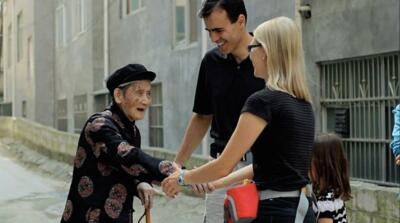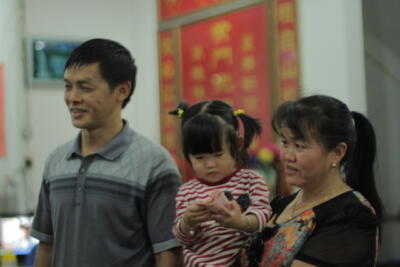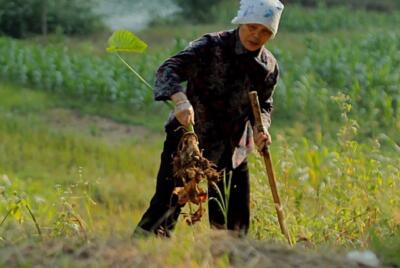#305 The 9 Secrets of The Longevity Plan Diet
 Dr. John Day
Dr. John DayDr. Day is a cardiologist specializing in heart rhythm abnormalities at St. Mark’s Hospital in Salt Lake City, Utah. He graduated from Johns Hopkins Medical School and completed his residency and fellowships in cardiology and cardiac electrophysiology at Stanford University. He is the former president of the Heart Rhythm Society and the Utah chapter of the American College of Cardiology. |

The Longevity Plan Diet
The centenarians of China’s Longevity Village, home to the highest percentage of centenarians in the world as described in our book The Longevity Plan, eat as they have always have–A bit of animal meat, but not much. Nothing processed. No added sugars. And, owing to the fact that most Chinese are lactose intolerant, no dairy products. Lots of roots and tubers. Lots of wild fruits, garden vegetables, nuts, seeds, and legumes. Whole grains, never refined, and not too much. In good times and bad, these foods have comprised the vast majority of their diets. A diet that contributed to remarkable health and almost complete absence of cardiovascular disease, cancer, or dementia.
Can it really be considered a “diet?”

In the Western world, the word diet tends to evoke a lot of confusion, consternation, and even emotional turmoil. It has all sorts of negative connotations. It tends to be thought of as a set of rules. But in China’s Longevity Village there were no rules. No one was “on a diet.” No one was counting calories or carbs. And with limited exceptions throughout history, they’ve always had enough.
Poor as they were, and still largely are, it was very rare for anyone to go hungry. In fact, as Boxin told me (pictured on the right), the only male centenarian in the village during the years 2012 through 2017 when the research was done for The Longevity Plan book, and as he demonstrated every time we shared a meal, the people of China’s Longevity Village ate as much as they wanted, although absolutely no one was obese.
Our Trip’s to China’s Longevity Village
Feng Chun (pictured on the far right), who cooks and serves most of our meals when we are in China’s Longevity Village, is a notorious food-pusher, and not just with the guests that stay in her family’s modest inn. I love watching her with her own family at mealtime. “Eat more! Eat More!”
The villagers of Bapan don’t have thou-shalt and thou-shalt-not lists of foods that align with the rules and regulations of the latest fad diet. They don’t have smartphone apps measuring “points.” They don’t have recommended daily allowance labels on the sides of food packaging. But what they do have, and what they have had for centuries, is geography. Much of their health miracle occurred because they were physically cut off from the rest of the world for millennia.
Even today, getting to the village isn’t easy. Chinese health-seekers, who make pilgrimages here from other parts of China, usually have to fly into Nanning, a large regional capital known as the Green City because of the lush surrounding forests. From there,
if the weather is good, it can take about four hours to make it to Bama County, and another hour to reach China’s Longevity Village. There’s only one road to the village, and summer monsoons can fell trees, create massive red mudslides, and turn the highway into a virtual river. When this happens, China’s Longevity Village can be cut off from the rest of the world for days at a time.
My First Meal in China’s Longevity Village
By the time I sat down for my first meal in the village, my expectations were quite high. And never in my life have such lofty expectations been completely obliterated by something even better. The short, round table was nearly covered with plates and bowls, each of them heaping with food. Of course there was a big steam pot of rice—a simple, unpolished varietal that, fully cooked, remained stiff but not crisp.
There was another pot of corn porridge. There was boiled pumpkin.There was a simple dish of finely shredded potatoes and carrots that had been tossed with a small bit of rice wine vinegar. There was a dish of lightly cooked onions and peppers. There were two different cooked greens, none of which I recognized at first but which I was later told were beet greens and pumpkin leaves and stalks; both had been stir-fried with garlic. There was also a rather bleak-looking gray soup with some green vegetables in it. In that and every other meal we ate in the village, I took note of what was on the table and tried to connect it to what I knew about the nutritional benefits of certain food types. The more I studied the The Longevity Plan village diet, the more I realized that there wasn’t anything particularly magical about the food in this place; they simply ate good food, and plenty of it.
1. Rice (and other unrefined grains)
It’s probably no surprise that the villagers eat a lot of rice. It’s offered with every meal, without any pomp or circumstance. While more Asians are eating white rice, these days, historically it was not this way in Longevity Village. Brown rice (that’s whole rice, including the bran and germ), is very filling while being relatively low in calories, and is a superb source of manganese, an antioxidant, which helps activate the metabolism of carbohydrates, amino acids, and cholesterol. Brown rice is also a great source of Vitamin B6, which helps our bodies make serotonin and norepinephrine, both of which are chemicals that help our brains communicate effectively and efficiently.
While rice is the most prevalent grain in Bapan, it’s not the only choice. Corn shows up in various meals in Longevity Village, but its central place in households is as part of a simple porridge, just mashed corn and water, many villagers have for breakfast each morning.
Corn is sometimes derided in the Western world, these days, largely because it’s the base ingredient in high fructose corn syrup, which now accounts for up to a fifth of the calories consumed in the United States. That, of course, is absolutely unhealthy. In its natural form, though, corn is an antioxidant and a great source of fiber. That’s good for gut health and helps make us feel full. In corn, as in all grains, though, the more processed it is, the worse off you are. In Bapan it’s always served on the cob or freshly cut from the cob.
The other grain that often shows up on Longevity Village plates is millet, an ancient grain that might actually have a longer history in China than rice, and which is a good source of complex carbohydrates, protein, and healthy fats. Even though it is generally available in the United States and quite delicious, millet doesn’t factor into a lot of common dishes in the Western world. That’s a shame. I’ve found it’s wonderful with onions, tomatoes, and spices in stuffed peppers. Those were the main grains in the Longevity Plan diet, but that’s absolutely not the same thing as saying other grains are bad.
There’s an important distinction, though, between whole or intact grains and processed grains. While there has been a recent flurry of books and websites demonizing grains in every form, the scientific literature does not support this belief. Processed grains, on the other hand, are little more than sugar, and it’s clear that these products are responsible for much of the obesity crisis, as well as the epidemic of atrial fibrillation, heart failure, and diabetes that I see in my cardiology practice every day.
For those seeking to lose weight, even the healthiest of whole grains should be eaten in moderation if at all. What most people don’t realize is that flour from grains is really nothing more than instant sugar for your body. Is it any wonder that even whole wheat bread is converted to sugar by the body faster than a Snickers bar? For me, once I was able to free myself of the addictive qualities of traditional flour-based whole wheat breads, I actually came to prefer the flourless varieties because they are more satisfying and don’t leave me craving more.
2. Nuts and Seeds
The Longevity Plan diet includes lots of different nuts and seeds, at least a serving or two every day. In China’s Longevity Village they especially like lots of peanuts and pumpkin seeds. Yes, I realize the lowly peanut is not technically a nut, but rather a legume. Nutritionally, though, it acts like a nut, and performs like one when it comes to maintaining a healthy weight, preventing cardiovascular disease and fighting back premature death. Pumpkin seeds are a superfood. They are an amazing source of biotin, a B vitamin that helps regulate DNA formation and helps protect against ischemic heart disease. They’re packed with protein, healthy fat, fiber, and magnesium, which has been connected to a significantly reduced risk of sudden cardiac death. As I teach my patients, when you follow the seven lessons in this book it’s quite unlikely that you will get hungry between meals. But if you do feel you need to snack, nuts, and seeds are a great nutrient-packed choice.
3. Sweet Potatoes
Sweet potatoes are served in Bapan for breakfast, lunch, and dinner, usually chopped and boiled to softness but not mushiness. They’re relatively cheap, easy to grow, and easy to store, and are one of the best sources in the world for beta-carotene, an antioxidant, which is converted in our bodies into vitamin A and helps maintain healthy skin.
Most of the villagers eat sweet potatoes several times a week. While I’m not a fan of the taste of a straight sweet potato, I don’t mind them as part of a stir-fry dish. Some people love them mashed. However you enjoy eating them is fine, provided you don’t undo the health benefits by what you put on them or how you cook it them. (Beware, for instance, of sweet potato fries, which are often fried in unhealthy oils and covered in sugar and salt.)
4. Vegetables and Fruits
Just a few steps outside of the village are lush hillsides rich with native fruits, berries, and, if you know what you’re looking for, sumptuous root vegetables. Like bass fishing pros racing their sport boats out to their favorite spots before anyone else can get three, it’s common to see villagers in this region out at first light double-timing to their secret foraging locations with an empty basket or sack dangling from their arms. Indeed, when you ask around these parts for the key to longevity, many people will tell you that, if there is such a thing, it simply must be the wild veggies and fruits.
“In the toughest times,” Boxin told me, “that was all we ate. But even in the best of times we never stopped foraging for this kind of food. It is the best food because it is the most natural food.”
Every meal in Longevity Village, including breakfast, is served with leafy green vegetables, a tremendously good source of vitamin K, which is vital to blood coagulation and helpful for strengthening bones. Despite the fact that it’s really easy to get your daily
dose of K ( just one serving of kale or spinach will do it for you) most Americans fall short. Other common village veggies include various varieties of bok choy (a great source of vitamins A and C), snake beans (basically a very long string bean, another good source of vitamin C and folate), and carrots (a mega-dose of beta-carotene).
As for fruits, the village bounty is a virtual Carmen Miranda hat’s worth of apples (which are well-known to ward off stroke and prevent dementia), mangoes (lots of antioxidants and a good way to protect against many cancers), figs (even more antioxidants, along with vitamins A, E, and K), papayas (high in folate and fiber and vitamin C), bananas (packed with B6 and manganese), melons (some types of which have been found to improve eye health and lower the risk of metabolic syndrome), and lychees (rich in vitamins C, manganese, and magnesium, they’ve long been used in Chinese medicine, in addition to being served on Chinese plates).
And then there are the peppers. While food in this region of China is bland by comparison to other parts of a country where cooks tend to push their creations toward the hotter side of the Scoville scale, just about every meal in Bapan was also served with some form of pepper. Researchers have shown that capsaicin, the active component of chile peppers that produces a burning sensation when it comes into contact with living tissue, can help increase metabolism and decrease appetite. And while hot peppers have the most capsaicin, even sweet peppers have some.
The villagers don’t have a magic number for how many vegetables and fruits they eat, but having “kept score” over the course of hundreds of meals with dozens of village families, I’ve noticed that most meals include three or four fruits and veggies, with the latter being favored by a 3:1 ratio. I advise my patients to eat at least two vegetables and one fruit at every meal. That’s nine servings of fruits and vegetables a day. And, as it happens, this is right in line with the American Heart Association’s current recommendation. That might feel to some people like an impossible target to hit. That’s because they don’t start at breakfast.
The standard American diet, after all, only sometimes includes fruit and rarely includes vegetables in the morning. Most of the time, it just includes foods that are either already made of sugar or are quickly processed by our bodies into sugar. That’s incredibly sad. If breakfast is the most important meal of the day, after all, then why not serve it with the most important foods? Veggies and fruits, in addition to being loaded with nutrients, are also excellent sources of dietary fiber. When we start the morning with a lot of them, we end up feeling satiated throughout the day.
One great way to get an early jump on your target of daily helpings is by turning two or three servings of vegetables and fruits into a smoothie. As an added bonus, throw in some seeds or nuts for protein and healthy fat. Healthy fat, protein, and fiber is the key to making it to lunch without hunger pains. Don’t dump in sugar or fruit juice; you don’t need it. If you must sweeten it a bit, try a little raw honey or a natural form of stevia. Just use some fruit, vegetables, nuts or seeds, and milk. And when it comes to milk, don’t limit yourself to just cow milk. Personally, I really prefer the myriad of alternatives, including unsweetened almond, hemp, soy, and coconut. Nobody in the village actually counts their veggies and fruits, though, and you probably shouldn’t either. Instead, an easy way to make sure you’re hitting the mark is to simply make sure most of your plate is covered with vegetables and some fruit at each meal.
5. Legumes
Legumes are another daily staple in China’s Longevity Village. As in most places in the Far East, edamame is eaten daily. Indeed, many people have credited the much lower rates of cardiovascular disease, cancer, and longevity in Japan to eating edamame.
But edamame is just the start. In Bapan, villagers eat many different beans, including mung beans, peas, and lentils of various shapes, sizes, and colors. That gives them a daily dose of a food that is high in protein, minerals, and fiber.
It’s not uncommon, though, for my patients to push back at my suggestion that they add more beans to their meals. Sometimes, they just don’t like the taste of beans all that much. In these cases I suggest trying them in homemade Indian food, chili, soup, or a dip like hummus. Dry roasted beans also make a great substitute for potato chips, and whole bean pasta is a lovely alternative to the processed grain variety.
6. Dairy
There’s no dairy in the traditional Longevity Plan diet. Like most folks across China, the people of Bama County are largely lactose intolerant. That might not be the case for you, and if you like and can tolerate dairy, a small amount of real cheese (not processed American cheese), especially made from the milk of a grass-fed cow, which has not been pumped up on antibiotics or hormones, probably isn’t going to hurt. Unfortunately, most Americans’ idea of a small amount of cheese is what we put on an average slice of pizza. That might be a small amount compared to what most people in the United States eat (23 pounds of cheese each year, about the same weight in cheese as an average one-year-old child!) but it’s really too much.
There do appear to be some health benefits to eating a little bit of cheese, particularly when it comes to creating a healthy gut flora, but whatever good it’s doing for us is almost completely obliterated by how much bad it does to us in the quantities and types of cheeses we typically consume. I’ve found that pizza is one of the toughest things for my patients (and me, too) to limit. If you love pizza, make a healthier version at home. We often add almond and coconut flour to our dough with fresh organic tomatoes, garlic, and olive oil for the sauce, sprinkled with a little organic cheese on top.
What about calcium? You don’t need cheese or even cow milk for that. And despite what the U.S. dairy industry would have you believe, you definitely don’t need three servings of dairy each day for healthy bones. As it turns out, in fact, some countries with the highest intake of dairy also have the highest rates of osteoporosis.
Yes, our bodies need calcium, but the idea that the best sources of it are products made of cow’s milk really needs to be squashed. Calcium is also readily found in green leafy vegetables, almonds, oranges, broccoli, fish, beans, seaweed, and many other foods.
If you do drink milk, does it matter if you go full fat, low fat, or non-fat? It is not clear at this time whether fat content is important at all. If you enjoy dairy, try unsweetened yogurt or kefir with live bacterial cultures, which have additional health benefits.
7. Oils
The first time Boxin saw cooking oil in a large plastic container, he was confused. He couldn’t understand how anyone would ever need that much oil for anything. “Maybe,” he remembered thinking, “it was for the entire village to use for the whole year.”
Until quite recently, there were absolutely no processed cooking oils in the village. What they used either came from the fish they cooked or from pressing hemp seeds, which is quite difficult to do using simple hand tools so they didn’t get much.
8. Fish
Longevity Villagers do eat a fair share of fish from the river. They call these you yu, which in Chinese simply means “oily fish,” and they have long been cherished as part of the village diet. In the morning, if the river (pictured on the right) is not too high, local fishermen will walk along the muddy banks, dragging a net along behind them for ten or twenty paces. When they lift the nets from the water, the little fish, no bigger than your pinky finger, glint like diamonds in the morning sunlight. They’re usually in a wok within the hour and on someone’s plate just minutes later. Served whole and eaten like French fries, they taste a little like sardines, though less pungent.
The prevalence of these fish in the village diet was quite interesting to me in light of research that was being conducted by Dariush Mozaffarian. He was finding that people who had higher levels of fish oil in their diets lived longer and had a much lower risk of dying from heart disease or stroke. Again and again I was finding that emerging Western medical research was quite well aligned with traditional village practices, most of which had little to do with conscientious healthfulness. The you yu were simply what happened to be swimming in the Panyang River.
The easiest counterparts to you yu in most American markets are sardines, anchovies, and herring. If you live close to the coast, you might also be able to get your hands on somesmelt from your local fishmonger. As in all other sorts of foods, wild and fresh is best, but fish that have been flash frozen aren’t a bad alternative. Anything that has been canned and packed in added oils should be avoided except as a delicacy—remember it’s the natural oils in these fish that help make them healthy for us. Water-packed fish can be a healthy alternative, too, but many are packed with a lot of salt, so be careful to watch the labels. The great thing about many of these choices, especially the smaller ones, is that they can be eaten whole or nearly whole, with skin and very small bones included, but the fins and skulls left behind. That sort of nose-to-tail eating, with an extra dose of calcium, closely resembles the way the villagers of Bapan eat.
There are plenty of other oily fish that are not quite so closely related in flavor or appearance to you yu, but can be a good substitute, too. To that end, I recommend the fish that are on the Super Green List of the Monterey Bay Aquarium’s Seafood Watch. The fish that make this list are lowest in mercury, highest in the healthy omega-3 fats, and are sustainably caught. The list includes Atlantic mackerel, freshwater Coho salmon, Pacific sardines, and, my favorite, wild Alaskan salmon.
9. Other Meat
Although I saw chickens running about and a few pigs being roasted, I didn’t see much meat on the tables of the village elders. Did they shun it? Were they against eating it on moral or religious grounds? Did they abstain for health reasons? “Oh no,” Boxin told me. “We like meat just fine, but many of us are just not used to having very much of it.”
Throughout his life, Boxin said, he has eaten no more than two small portions of meat of any kind each week, and there was no animal that he considered off-limits to ending up in his bowl. The reason that people throughout Bama County have not historically eaten a lot of meat is simple and logical, Boxin said. Keeping animals was a surefire way to draw the attention of marauding armies. Given the region’s turbulent history, any animals that were kept were quickly confiscated, if not by warlords and hungry soldiers then by government officials.
“The only food that could not be easily taken,” he said, “is what came from the ground or the river.”
What diet is best for you?
Cheese or no cheese? Meat or no meat? Kosher or Halal? Paleo, vegetarian, keto, or Atkins? What should you do? Well, you should trust yourself. Your genes are different than anyone else’s. Your diet probably should be, too.
The truth is that across time and around the world people have thrived on many different diets. Just about the only diet that doesn’t seem to work for anyone is the Standard American Diet—the acronym for which, SAD, is as appropriate as they come.
If you’re working hard to minimize or even avoid sugar, eat lots of vegetables, and get rid of processed foods, then you’re probably doing a good job for your health and the health of your family, regardless of your other eating habits. And if you’re struggling with that, as just about all of us have at times, then you’re not alone.
The important thing to know is that there is no quick fix. I had to learn that lesson, too.
When I first came to Longevity Village, I believed that I would be able to hone in on a dietary secret that would lead to a longer, healthier, happier life. And it’s true that I learned a lot about food and our relationship with food during that first trip. But during that stay, and in all my time in Bapan since then, I’ve learned so much more. And perhaps the most important thing I’ve learned is that the best thing we can do for our health is to make sure that eating isn’t a vice, but rather a virtue.
Food Shouldn’t Isolate Us
Confucius once said, we should “not, even for the space of a single meal, act contrary to virtue.” When I learned this I was devastated. I figured it was impossible. I might eat lots of veggies, fruits, and legumes. But what if my family or friends were to invite me out to pizza? What if I wanted to share an ice cream sundae with my daughter? Would that be acting contrary to virtue?
When I asked Boxin what he thought of Confucius’ instructions, he gazed out of his open parlor and paused contemplatively for several seconds. “Virtue isn’t just one thing we do,” he said. “It’s everything we do.” Virtue, I’ve since come to believe, isn’t just what we eat. It’s how we eat. It’s who we eat it with. It’s our relationship with where our food comes from. It’s the decisions we make about how to prepare it. It’s our determination to honor the energy it gives us in positive ways.
Disclaimer Policy: This website is intended to give general information and does not provide medical advice. This website does not create a doctor-patient relationship between you and Dr. John Day. If you have a medical problem, immediately contact your healthcare provider. Information on this website is not intended to diagnose or treat any condition. Dr. John Day is not responsible for any losses, damages or claims that may result from your medical decisions.


Thank you so much for sharing your wisdom from your trips! By the grace of Jesus Christ I’m going to apply this wisdom. I have had atrial fib for two years. I am in the top 5 percentile of the worst sleep apnea in America. And I need to lose 100lbs. I am a 56 yr old white female. I truly believe the Lord led me to your article. Thank you!